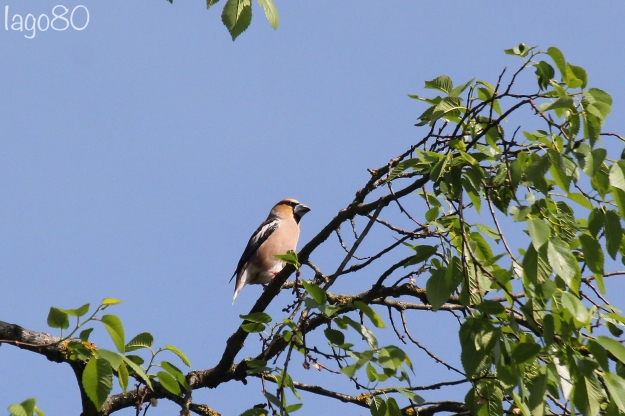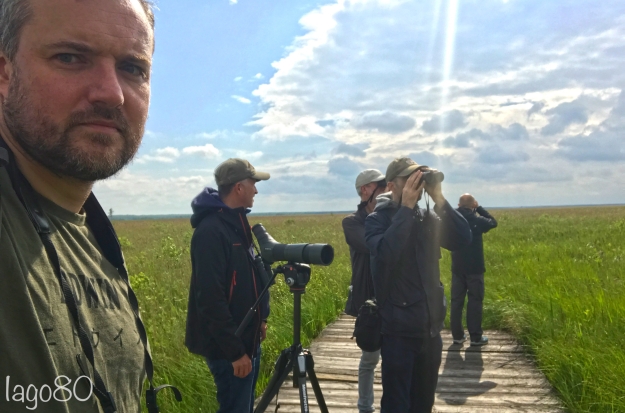I was straggling at the back of our small group on an unsuccessful walk in the hope of finding Hazel Grouse when I heard something. At first it took my mind a few seconds to register the sound. But on the third or fourth occasion the sound penetrated me at a deeper, primal level. A long, distant, moaning howl. I stopped, felt a small surge of adrenaline and felt my senses sharpen. This was my first wild experience of Wolf in Europe.
The day before, we had encountered an even more distant relic of Europe’s all-but-entirely lost megafauna: Bison.

European Bison (Bison bonasus)
Our experience of the Białowieża forests began exceptionally early in the morning on the Saturday. It felt like we were tracking something; a guide-led walk to a known nesting site. That nesting site happened to be in a wooded wetland largely created by Beaver.

How often do we see sights like this in the UK? I would contend very rarely indeed. We no longer have Beaver (other than a few trial reintroductions in Scotland, but lets hope that increases soon), and our country is the most denuded of forest of any country (other than the tiny city-states) in Europe. Where we do have woodland, they are largely lifeless plantations or forests managed and fenced off for pheasant shooting.
The Woodpeckers
This site was to be our first encounter with a target woodpecker. And we did indeed get views of White-backed Woodpecker – a life-tick for me and one or two of the others. We didn’t stay long as the mosquitoes were vicious and legion.
A few minutes drive and another spot of forest where we watched a pair of Middle Spotted Woodpecker making multiple visits to their nest hole.

Middle Spotted Woodpecker (Dendrocoptes medius) – Female in hole and male to right
At the same site we had our first trip encounter with Black Woodpecker; only my second ever. I remember the first time I heard, then saw, one and being taken aback by how loud and big it is (read about that here). The feeling was similar on this occasion – it sounds like an effing dinosaur (I imagine) and the drumming is that of heavy machinery rather than a bird. Later in the day we watched in awe as one of these giants tore a rotting tree trunk to shreds with a large pile of wood chips accumulating at the base.

Black Woodpecker (Dryocopus martius) through a gap in the hornbeam leaves
At the other end of the size scale, we felt lucky to get a single view of a Lesser Spotted Woodpecker (a bird I am sad to say I have only seen on three occasions in the UK).
Whilst neither Black nor Lesser were ‘ticks’ for me, the next two woodpeckers were. Bob helped locate the only Three-toed Woodpecker we were to encounter on the trip and this led to the guide discovering its exact nest location. We watched from a respectable distance.

Eurasian Three-toed Woodpecker (Picoides tridactylus)
Finally, on a second attempt, we watched a Grey-headed Woodpecker emerge and then fly from its nest in some parkland near the strict reserve forest.

Grey-headed Woodpecker (Picus canus) – this was the only photo our group got of this bird
We saw and heard our familiar Great Spotted Woodpecker on numerous occasions but failed to connect with the common Green Woodpecker or Wryneck (which also breed locally). We also made an aborted attempt to see Syrian Woodpecker in Warsaw. The point I am building to with this rather rapid list is that ten of the eleven species of woodpecker which breed in Europe are found locally in Eastern Poland. It was just one sign of many that we saw, on our whistle-stop tour, of the diversity which can be found when natural habitats are preserved or left untouched. The contrast with the UK could not be more stark.
A similar point could be made about owls found locally. As it was, we actually only saw one: a life-tick for me as Europe’s smallest owl, the Pygmy Owl, peered out of its hole to investigate the possible Pine Marten scraping at its tree (which was actually our guide with a stick).

Eurasian Pygmy Owl (Glaucidium passerinum)
The Flycatchers
A different guide walked us around the Strict Reserve. She was an expert in Collared Flycatcher and told us that in some years there are more recorded in the forest than Chaffinch! The gloom of the forest meant that the photos I got belied just how wonderful our views of this species were.

Collared Flycatcher (Ficedula albicollis)
It was a similar case with the stunning Red-breasted Flycatcher and a handful of Spotted Flycatcher. It was great to see these birds in song, and nesting in their home environment as flycatchers (Spotted and Pied that is) are just passage migrants on our Patch back home.

Red-breasted Flycatcher (Ficedula parva)
The Wood Warbler and the hidden birds
In my three and half years of birding the local Patch, we have had a single Wood Warbler singing from the tiny copse we call Motorcycle Wood. In Białowieża, the forests rang out with the wonderful song of these stunning birds.

Wood Warbler (Phylloscopus sibilatrix)
As with forests everywhere, birds are not exactly easy to find or see – our failure to see Hazel Grouse or Nutcracker is certainly testament to that. Woodland tits were harder than I expected in Poland: Great Tit, Blue Tit and Long-tailed Tit seemed less numerous than I am used to in the UK; we only heard one Coal Tit once or twice on the trip, and had no sign of Marsh Tit, Willow Tit, or Crested Tit (although we are aware that they are there).
Such is the enigma of forests. They teem with life and yet the ‘life’ does not always make itself easily found. We were aware that the forests hold Lynx, but did not expect to see one (nor did we).

The long walk back from an unsuccessful search for Tengmalm’s Owl
The trees
The majestic parkland oaks we are used to seeing in the UK, rotund and sprawling, are virtually anathema to primary forests. There is far too much competition for such overindulgent horizontal growth. I remember the thinner, taller trees in the wonderful Atlantic oak forests on the west coast of Scotland. But I was taken aback at the size (girth, but particularly height) of some of the trees in Białowieża. They seemed to be freakishly tall versions of familiar trees we are used to in the UK. Maybe that is what thousands of years of uninterrupted survival of the fittest does in a forest?

The fringes
Some birds seemed easier to find on the fringes of the forest; often as different habitats met. And so it was on the edges of Białowieża village, where we picked up good views of Hawfinch, Golden Oriole, Rosefinch, Barred Warbler, Tree Sparrow, Red-backed Shrike and lots more. It was often in these fringe areas where from within deep vegetation we would listen to, and on one occasion had reasonable views of, Thrush Nightingale which was another life tick for me.

Hawfinch (Coccothraustes coccothraustes)

Female Red-backed Shrike (Lanius collurio)

Tree Sparrow (Passer montanus)

Thrush Nightingale (Luscinia luscinia)
The lesson
Białowieża opened my eyes to what much of Europe, including the UK, could and, perhaps, should be like. Białowieża began, for me, as a place in my imagination, but let’s all hope that it remains a reality for Europe and for the world. Primary forest is part of the primal heritage of all of us; wired into our instinctive synapses. To lose it altogether is surely to lose something deep within our identity. I think we all need the wake-up call in the form of the penetrating howl of a wolf or a Black Woodpecker drumming into our skulls the message of fragile vitality that exists in the remaining fragments of our once great forests.

















